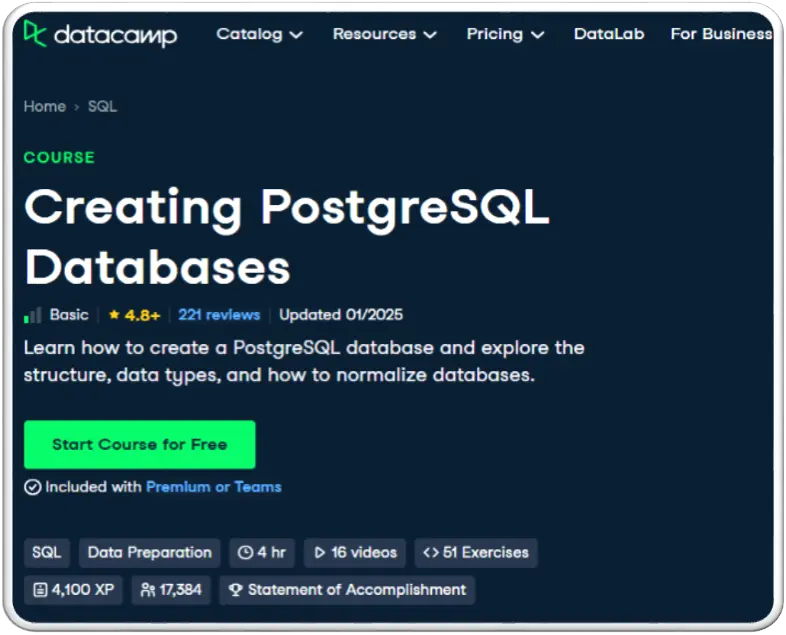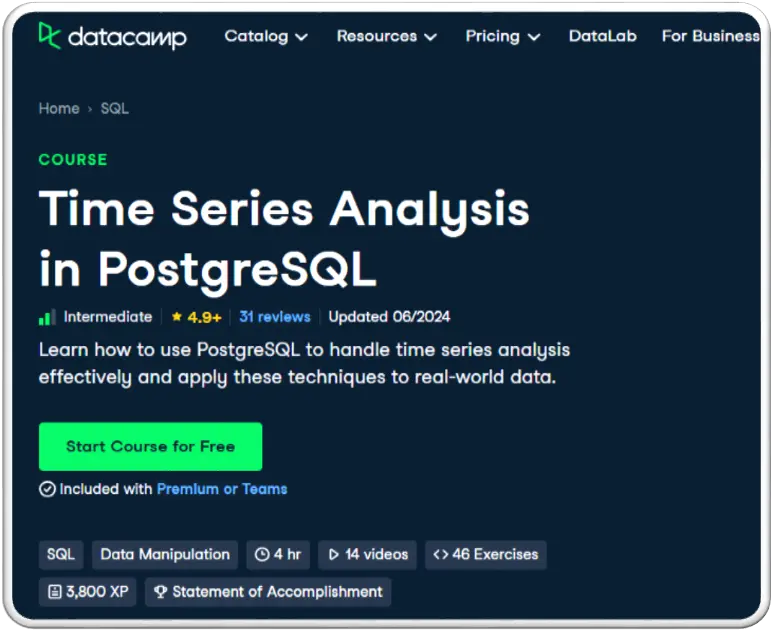
To avoid wasting your precious time, don’t download this PostgreSQL Cheat Sheet solely for memorizing the commands. To be frank, most of the PostgreSQL users don’t remember 80% of the commands, and they don’t need to.
Have you ever wondered how the professionals use this PostgreSQL Cheat Sheet? They use it as a PostgreSQL Cheat Sheet and practice a lot on FREE Edtech platforms like LearnSQL and DataCamp. Later, it becomes their digital portfolio to showcase in their resume and in front of the hiring manager during their technical interview.
As I’ve promised in blog title, this is the only Postgres Cheat Sheet you’ll ever need. Whether you’re a student, an analyst, or a backend developer trying to debug any psql commands, this blog contains invaluable Postgres Cheat Sheet and psql commands that will save your valuable time.
My Personal Story
Before I present you with this blog, let me tell you my personal short story, which is the root cause for this Postgres Cheat Sheet and psql commands. It was a usual internship day during my college studies at an automotive company. I had to fix a report that was constantly failing due to missing data from a PostgreSQL database. The dashboard was live and accessed by top management. Every time the data failed to load, the pressure was on me.
One of my senior helped me fix it and handed me a printed Postgres cheat sheet PDF. He looked at me and said, “Don’t Google every time. Keep this as a handbook and practice a lot in LearnSQL.” That moment was an eye-opener for me to decide that, “I should not memorize the code anymore; rather, I should memorize the concept by practicing a lot as he advised.”
Since then, I’ve refined my own PostgreSQL Cheat Sheet, keeping only what matters. I’m writing this article as your Go-to Postgres Cheat Sheet and psql Commands.
1. PostgreSQL Basic Commands
Here are some PostgreSQL basic commands to remember and keep it every time you interact with databases.
- Connect to database:
psql -d your_database- Connect to PostgreSQL with a user:
psql -U username- Connect to a specific database:
psql -d dbname -U username- List all databases:
\l- Connect to another database (from within psql):
\c dbname- List all tables in the current database:
\dt- Describe table:
\d table_name- Create database:
CREATE DATABASE db_name;- Quit:
psql \qYou can bookmark this section as your daily postgresql commands cheat sheet.
2. PostgreSQL SQL Queries
To speed up your querying process, use this PostgreSQL SQL queries with most-used queries with practical examples.
- SELECT data:
SELECT * FROM table_name;- INSERT data:
INSERT INTO table_name (col1, col2) VALUES (val1, val2);- UPDATE records:
UPDATE table_name SET col1 = val1 WHERE condition;- DELETE data:
DELETE FROM table_name WHERE condition;- JOIN example:
SELECT u.name, o.order_id FROM users u JOIN orders o ON u.id = o.user_id;- GROUP BY
SELECT department, COUNT(*) FROM employees GROUP BY department;- DISTINCT values
SELECT DISTINCT country FROM customers;Keep this cheat sheet handy to reduce errors and streamline your work.
Need more like these? Check out this detailed SQL server interview blog.
3. PostgreSQL Data Types Cheat Sheet
A reliable postgres data types cheat sheet keeps your schemas clean.
- Integer types:
SMALLINT, INTEGER, BIGINT- Serial types:
SERIAL, BIGSERIAL- Decimal/Float:
NUMERIC, REAL, DOUBLE PRECISION- Text:
CHAR(n), VARCHAR(n), TEXT- Date & Time:
DATE, TIME, TIMESTAMP, INTERVAL- Boolean:
BOOLEANThis list is the core of every cheat sheet used by developers.
4. PostgreSQL Syntax Cheat Sheet
Clean code starts with syntax. This PostgreSQL syntax cheat sheet helps you avoid rookie mistakes.
- Alias:
SELECT col AS alias- Join:
SELECT * FROM a JOIN b ON a.id = b.a_id;- Subquery:
SELECT * FROM (SELECT col FROM table) AS sub;- Group By:
SELECT col, COUNT(*) FROM table GROUP BY col;4.1 PostgreSQL vs MySQL Cheat Sheet
Need a fast PostgreSQL-to-MySQL translation? Here is your quick “MySQL to PostgreSQL cheat sheet”:
| Action | MySQL Example | PostgreSQL Example |
| Show databases | SHOW DATABASES; | \l |
| Show tables | SHOW TABLES; | \dt |
| Describe table | DESCRIBE tablename; | \d tablename |
| Limit results | SELECT * FROM table LIMIT 10; | SELECT * FROM table LIMIT 10; |
| Create user | CREATE USER …; | CREATE USER …; |
| String concat | SELECT CONCAT(a, b) FROM table; | SELECT |
Explore more syntax differences on my recent medium blog about, Advanced SQL Interview Questions.
5. psql Commands Cheat Sheet
A fast psql commands cheat sheet for every terminal warrior.
- Clear screen:
\! clear- Quit psql:
\q- Get help:
\?- Connect to new DB:
\c db_name- Execute SQL file:
\i file.sql- List indexes:
\diPrint this postgres psql cheat sheet and stick it near your screen.
6. Best PostgreSQL Courses
During your technical interview round on PostgreSQL assessment, most of the MNCs and tech companies demand key know-hows such as scenario questions on schema design, roles and permissions, indexing, transactions, and performance tuning all in a live test conducted over 30-60 minutes with strict scoring.
To tackle these rapid tests under time pressure, you must be equipped with practical knowledge. That’s what provoked me to find these two platforms, especially since their courses are packed with the technical know-how you need and the practical experience required to crack your next PostgreSQL assessment.
6.1 Creating PostgreSQL Databases (Beginner) at DataCamp
In this highly industry-demanded course, you’ll learn the core build blocks hiring teams expect, such as CREATE DATABASE, CREATE SCHEMA, naming rules, and how PostgreSQL structures objects.
This course allows aspirants like you to practice creating tables and schemas, understand the public schema, and learn when and how to segment data across schemas for teams and business units.
It also guides you directly through admin and setup steps exactly what you’ll encounter in entry tests and take‑home tasks.
Course highlights:
- Structure of PostgreSQL databases and objects, with straight‑to‑the‑point CREATE commands.
- Practical schema usage for multi‑user environments and clean separation of business domains.
- Beginner‑friendly guidance for handling real database setup work confidently.
6.2 Time Series Analysis in PostgreSQL (Intermediate) at DataCamp
For Intermediates, DataCamp offers this real-time production project letting you work with date/time data as analysts and engineers do in their daily coding lives. You’ll practice converting between types, control time zones, change granularity, and compute rolling metrics with window functions.
You will gain hands on practice of DATE_TRUNC, EXTRACT, TO_CHAR, TO_TIMESTAMP, and Unix time conversion, then build running totals, moving averages, and partitions for ranked insights.
This course helps you to “write the correct query quickly” a skill that most MNCs and tech companies evaluate to judge a candidate’s precision and speed in PostgreSQL coding rounds.
Course highlights:
- Technical insights into date/time data types, parsing, and formatting for clean pipelines.
- Hands-on practice with time zone handling and granularity shifts for daily, weekly, monthly reporting.
- Applying window functions for running totals, averages, and ranking on real time‑series tasks.
6.3 Become a Pro in PostgreSQL with LearnSQL’s 129+ interactive challenges
If you need a solid base or quick practice, LearnSQL’s SQL Basics and tracks give you 129+ interactive challenges, certificates, and clear coverage of JOINs, GROUP BY, subqueries, and set operations topics that feature in every SQL screening.
The platform gives you access to 78+ hands‑on courses, assessments, and an exam‑based Certificate of Competency to validate your level for recruiters.

From my perspective, this is the quickest way to fill knowledge gaps before signing up for any advanced PostgreSQL course or technical interviews.
Platform strengths:
- Structured learning paths across standard SQL and PostgreSQL, with practice tracks for speed.
- Earn a globally recognized competency certificate to stand out in any resume screening.
6.4 Roadmap to becoming a Pro in PostgreSQL
- Step #1 : Start with Creating PostgreSQL Databases and learn to set up clean structures that pass admin and schema rounds with confidence.
- Step #2 : Take Time Series Analysis in PostgreSQL to master the functions used in real dashboards and interview tasks.
- Step #3 : Use LearnSQL.com to improve your SQL fundamentals and earn a certificate to help get your resume noticed fast.
Are you ready to hear another, “We’ll get back to you,” or are you ready to take action by enrolling today, practicing this month, and showing measurable progress by the 1st week of next month?
7. PostgreSQL Injection Cheat Sheet (for Security Awareness)
If you’re not aware of the postgresql injection cheat sheet, your app is at risk.
7.1 Avoid this:
SELECT * FROM users WHERE username = '$input';7.2 Use parameterized queries:
PREPARE stmt AS SELECT * FROM users WHERE username = $1; EXECUTE stmt('safe_user');Never skip this part in your commands.
7.3 MySQL to PostgreSQL Cheat Sheet
Here’s your quick mysql to postgresql cheat sheet for migration.
AUTO_INCREMENT in MySQL becomes SERIAL in PostgreSQLMySQL backticks `` become double quotes "" in PostgreSQL
SHOW TABLES; in MySQL = \dt in PostgreSQLLIMIT x, y in MySQL = LIMIT y OFFSET x in PostgreSQLUse this during every cross-database migration.
8. Backup and Restore with PostgreSQL
To avoid by “data lost!” dead end, I used to save and recover my data fast with this backup and restore commands in PostgreSQL.
- Backup the entire database:
pg_dump dbname > backup.sql- Restore the database:
psql dbname < backup.sql- Backup all databases:
pg_dumpall > alldb_backup.sql- Restore all databases:
psql -f alldb_backup.sql postgres- Create a custom backup:
pg_dump -Fc dbname > db.dump- Restore from custom format:
pg_restore -d dbname db.dumpI hope by incorporating these backup and restore commands in PostgreSQL, you will never lose your data and tedious work.
If you are preparing for your next SQL Server Interview, check out my another blog, SQL Server Interview Questions which contains 30+ real-time questions asked in MAANG tech giants for all levels.
9. PostgreSQL Cheat Sheet FAQs
Here are the most frequently asked questions by users about this PostgreSQL Cheat Sheet topic.
Q1. What is the difference between psql and PostgreSQL?
PostgreSQL is the database system. psql is the command-line interface. Use the recommended commands to operate PostgreSQL efficiently.
Q2. Where can I download a PostgreSQL cheat sheet PDF?
Grab this FREE PostgreSQL Cheat Sheet from my notion is great for your offline reference.
Q3. Is there a PostgreSQL injection cheat sheet?
Yes. Refer to OWASP and the section above for a detailed PostgreSQL SQL injection cheat sheet.
Q4. What is the best Postgres command line cheat sheet for daily use?
Check the basic commands and psql commands section in this blog. They form the backbone of your CLI workflow.
Q5. Can I use this PostgreSQL cheat sheet to prepare for interviews?
Of course Yes. Check out this blog Advanced SQL Interview Questions for real-time interview questions.
Q6. Where can I find PostgreSQL syntax examples?
Scroll to the PostgreSQL Syntax Cheat Sheet section. It has 4+ practical examples.
Q7. What is the best way to memorize PostgreSQL commands?
Use repetition and this PostgreSQL Cheat Sheet. Avoid memorization. Use daily.
Q8. Can I migrate from MySQL using this sheet?
Yes. See the MySQL to PostgreSQL Cheat Sheet for the top 4 changes you must make.
Q9. Is there a difference between serial and bigserial?
Yes. serial uses INTEGER. bigserial uses BIGINT for larger range.
Q10. How do I run a SQL file in PostgreSQL?
Use \i filename.sql inside psql. It’s already in the psql commands cheat sheet above.
Also, link back to this PostgreSQL Cheat Sheet whenever you feel stuck. Share it with a teammate who always forgets \q.
📬 Need 1:1 help? Let’s connect → Mohammed Azarudeen Bilal – LinkedIn



Add a Comment